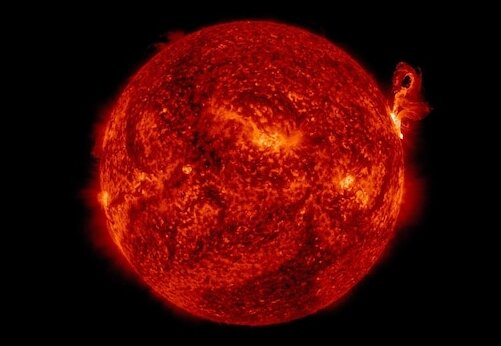
Solar flares could lead to geomagnetic storms on Earth

Earth may be in for auroras over the next few days following a series of eruptions of the Sun.
A sunspot called AR2929 has emitted two solar flares, accompanied by coronal mass ejections (CMEs). Although neither was directed at Earth, the ejections may deliver glancing blows to our planet’s atmosphere that could cause minor geomagnetic storms (disturbance of Earth’s magnetosphere).
The first flare took place on January 18, and was categorised as an M1.5 class-flare. The second more powerful erupted on January 20. Both are considered mid-level flares – not the most powerful activity of which the Sun is capable, but plenty strong enough for its effects to be felt on Earth.
According to spaceweather.com, during the flares, pulses of X-rays ionised the top of Earth’s atmosphere, causing a shortwave radio blackout around the Indian Ocean. “Aviators, mariners, and ham radio operators in the area may have noticed unusual propagation effects at frequencies below 30 MHz,” it said.
CMEs, which are caused by magnetic field lines snapping and reconnecting, are massive ejections of up to billions of tons of plasma from the solar corona, carrying an embedded magnetic field. These often occur in concert with solar flares, and travel outwards from the Sun, taking several days to arrive at Earth if they’re heading in our direction.
Flares are becoming more common as the Sun ramps up to solar maximum, the peak of solar activity that occurs over an 11-year cycle.
This cycle is based on the Sun’s magnetic field, which flips every 11 years, with the north and south magnetic poles switching places. It’s not known what drives these cycles (recent research suggests it has to do with an 11.07-year planetary alignment), but the poles switch when the magnetic field is at its weakest, also known as the solar minimum.
The Sun’s magnetic field controls its activity, including sunspots (temporary regions of strong magnetic fields), solar flares, and CMEs, so the solar minimum manifests as a period of minimal activity. After the poles have switched, solar activity gradually ramps up to maximum, when the Sun is at its rowdiest.
The most recent solar minimum took place in December 2019. We’re currently in the ramping up stage, heading for a solar maximum in around July 2025.

